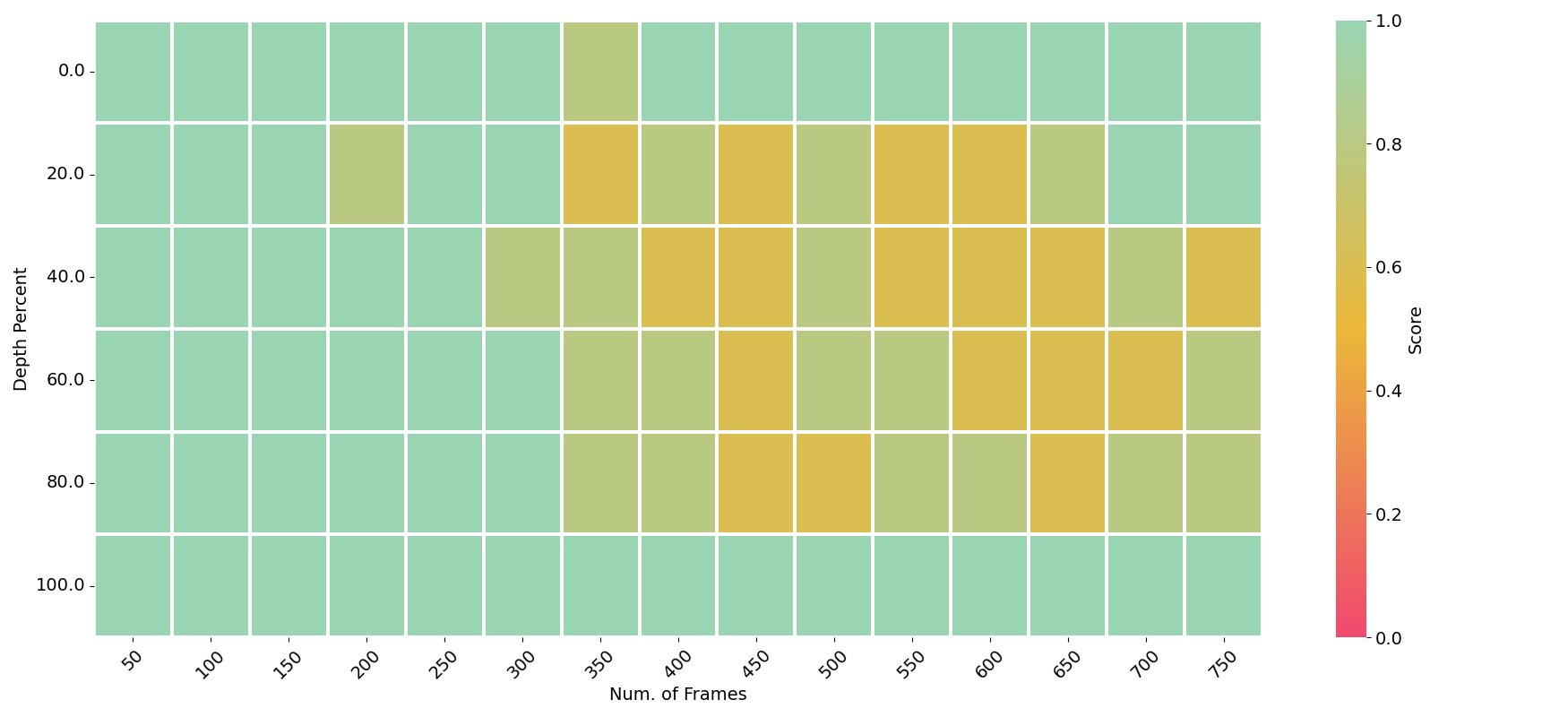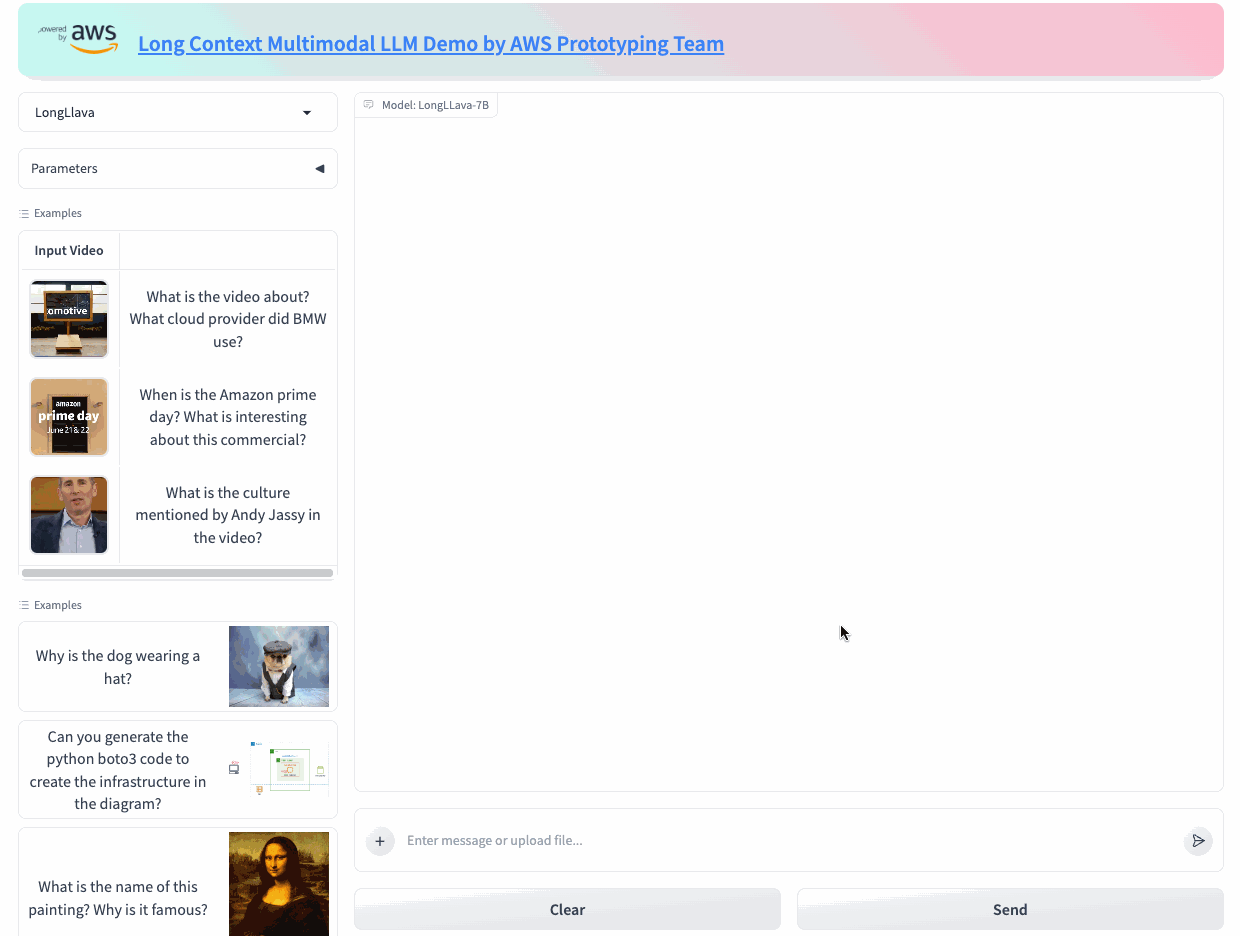long-llava-qwen2-7b Model
Most long context LLMs can only work in text-only mode, long-llava-qwen2-7b is a open source large-Context Multimodal LLM and can perform language, image, and video understanding. In stead of proposing a new model archiecture, we extended llava to support make it support long context in a multimodal setting (i.e., multiple images, short and long videos). long-llava-qwen2-7b was fine-tuned from Qwen2-7B-Instruct.
Model Details
- Developed by: AWS Contributors
- Model type: llava
- Supported languages: 27 additional languages besides English and Chinese
- Western Europe: German, French, Spanish, Portuguese, Italian, Dutch
- Eastern & Central Europe: Russian, Czech, Polish
- Middle East: Arabic, Persian, Hebrew, Turkish
- Eastern Asia: Japanese, Korean
- South-Eastern Asia: Vietnamese, Thai, Indonesian, Malay, Lao, Burmese, Cebuano, Khmer, Tagalog
- Southern Asia: Hindi, Bengali, Urdu
- Finetuned from weights: Qwen2-7B-Instruct
- Supported Serving Framework:
- Model License: Apache 2.0
- Contact: GitHub issues
- Inference Code Github Repo
Evaluations
1. Visual Needle In A Haystack - Pressure Testing LLMs Visual Needle-In-A-Haystack (V-NIAH), a purely synthetic long vision benchmark inspired by the language model's NIAH test. The test designed 5 video question-answering problems as the needle and inserted each as a single frame into hours-long videos. We sampled the videos at 1 FPS as the visual input. The image of the needle is sourced from existing VQA benchmarks or AI-generated to avoid any contamination. The AI-generated images and questions are purposely chosen to be "counterfactual" or "counter-commonsense", ensuring the model cannot answer based on language knowledge alone. Each question includes a "locating prompt" so that a capable system or human can locate the needle frame from the video haystack and answer the question.
The horizontal axis depicts the cumulative frames constituting the video haystack. The vertical axis indicates the positioning of the needle image within that sequence. For example, a frame depth of 0% would situate the needle image at the outset of the video. The black dotted line signifies the training duration of the backbone language model, with each frame comprising 576 tokens.
long-llava-qwen2-7b scored averagely ~88.0% on this NIAH benchmark across different numbers of frame depths and frames shown in this plot.
2. MME: A Comprehensive Evaluation Benchmark for Image Understanding
MME is a comprehensive evaluation benchmark for multimodal large language models. It measures both perception and cognition abilities on a total of 14 subtasks, including existence, count, position, color, poster, celebrity, scene, landmark, artwork, OCR, commonsense reasoning, numerical calculation, text translation, and code reasoning. long-llava-qwen2-7b achieves SOTAs on both perception and cognition evaluation.
| Models | mme_cognition_score | mme_percetion_score |
|---|---|---|
| long_llava_qwen2_7b | 350 | 1494.64386 |
| llava_1.5_7b_hf | 326.42857 | 1492.13225 |
3. VideoMME: Comprehensive Evaluation Benchmark of Multi-modal LLMs in Video Understanding
Video-MME, the first-ever full-spectrum, Multi-Modal Evaluation benchmark of MLLMs in Video analysis.It covers a wide range of short videos (< 2min), Medium Video (4min ~ 15min), long video (30min ~ 60min). 900 videos with a total of 254 hours are manually selected and annotated by repeatedly viewing all the video content, resulting in 2,700 question-answer pairs. Also, subtitles are also provided with the video for evaluation.
long-llava-qwen2-7b scored a overall 57.1% with subtitles and 52.9% with as shown in this table (adapted from the VideoMME Leaderboard), which makes it the SOTA for 7B models.
| Models | LLM Params | Overall (%) - w/o subs | Overall (%) - w subs |
|---|---|---|---|
| long_llava_qwen2_7b | 7B | 52.9 | 57.1 |
| LongVA | 7B | 52.6 | 54.3 |
| VideoLLaMA 2 | 7B | 47.9 | 50.3 |
| ShareGemini | 7B | 43.2 | 47.9 |
| Chat-UniVi-v1.5 | 7B | 40.6 | 45.9 |
| VideoChat2-Mistral | 7B | 39.5 | 43.8 |
| ST-LLM | 7B | 37.9 | 42.3 |
| Qwen-VL-Chat | 7B | 41.1 | 41.9 |
| Video-LLaVA | 7B | 39.9 | 41.6 |
Local Demo
This example demonstrates long_llava_qwen2_7b's long context capability by understanding both images and videos. This can be useful for onboarding new developers.
Run the Demo on your local machine (Mininum Requriement: g5.4xlarge is recommended.)
To get started, please follow the instructions as below:
git clone https://github.com/awslabs/extending-the-context-length-of-open-source-llms.git
cd extending-the-context-length-of-open-source-llms/long-llava-qwen2-7b
conda create -n long-llava python=3.12 -y
conda activate long-llava
pip install -r local_demo/requirements.txt
python local_demo/multimodal_chat.py
And then open your broswer at http://localhost:6006 or https://xxxxxxxxxxxx.gradio.live if share=Ture is enabled in local_demo/multimodal_chat.py.
How to use the model from Python Code (HuggingFace transformers)
First, make sure to have transformers >= 4.42.0.
The model supports multi-image and multi-prompt generation. Meaning that you can pass multiple images in your prompt.
Using pipeline:
Below we used "aws-prototyping/long-llava-qwen2-7b" checkpoint.
from transformers import pipeline
from PIL import Image
import requests
model_id = "aws-prototyping/long-llava-qwen2-7b"
pipe = pipeline("image-to-text", model=model_id)
url = "https://huggingface.co/datasets/huggingface/documentation-images/resolve/main/transformers/tasks/ai2d-demo.jpg"
image = Image.open(requests.get(url, stream=True).raw)
# Define a chat histiry and use `apply_chat_template` to get correctly formatted prompt
# Each value in "content" has to be a list of dicts with types ("text", "image")
conversation = [
{
"role": "user",
"content": [
{"type": "text", "text": "What does the label 15 represent? (1) lava (2) core (3) tunnel (4) ash cloud"},
{"type": "image"},
],
},
]
prompt = processor.apply_chat_template(conversation, add_generation_prompt=True)
outputs = pipe(image, prompt=prompt, generate_kwargs={"max_new_tokens": 200})
print(outputs)
>>> {"generated_text": "\nUSER: What does the label 15 represent? (1) lava (2) core (3) tunnel (4) ash cloud\nASSISTANT: Lava"}
Using pure transformers:
Below is an example script to run generation in float16 precision on a GPU device:
import requests
from PIL import Image
import torch
from transformers import AutoProcessor, LlavaForConditionalGeneration
model_id = "aws-prototyping/long-llava-qwen2-7b"
model = LlavaForConditionalGeneration.from_pretrained(
model_id,
torch_dtype=torch.bfloat16,
low_cpu_mem_usage=True,
).to(0)
processor = AutoProcessor.from_pretrained(model_id)
# Define a chat histiry and use `apply_chat_template` to get correctly formatted prompt
# Each value in "content" has to be a list of dicts with types ("text", "image")
conversation = [
{
"role": "user",
"content": [
{"type": "text", "text": "What are these?"},
{"type": "image"},
],
},
]
prompt = processor.apply_chat_template(conversation, add_generation_prompt=True)
image_file = "http://images.cocodataset.org/val2017/000000039769.jpg"
raw_image = Image.open(requests.get(image_file, stream=True).raw)
inputs = processor(images=raw_image, text=prompt, return_tensors='pt').to(0, torch.float16)
output = model.generate(**inputs, max_new_tokens=200, do_sample=False)
print(processor.decode(output[0][2:], skip_special_tokens=True))
Model optimization
4-bit quantization through bitsandbytes library
First make sure to install bitsandbytes, pip install bitsandbytes and make sure to have access to a CUDA compatible GPU device. Simply change the snippet above with:
model = LlavaForConditionalGeneration.from_pretrained(
model_id,
torch_dtype=torch.float16,
low_cpu_mem_usage=True,
+ load_in_4bit=True
)
Use Flash-Attention 2 to further speed-up generation
First make sure to install flash-attn. Refer to the original repository of Flash Attention regarding that package installation. Simply change the snippet above with:
model = LlavaForConditionalGeneration.from_pretrained(
model_id,
torch_dtype=torch.bfloat16,
low_cpu_mem_usage=True,
+ use_flash_attention_2=True
).to(0)
Serve the model on vLLM
On an AWS g5.4xlarge or larger instance, install vLLM as per vLLM docs.
pip install vllm==0.5.5
Start the server
vllm serve aws-prototyping/long-llava-qwen2-7b \
—max_model_len 8192
Important Note - Currently vLLM serving only supports single image inference. The support of multiple images as input is on the roadmap, and please refer Multi-modality Support Refactoring for details.
Run the client
import base64
import requests
from openai import OpenAI
# Modify OpenAI's API key and API base to use vLLM's API server.
openai_api_key = "EMPTY"
openai_api_base = "http://localhost:8000/v1"
client = OpenAI(
# defaults to os.environ.get("OPENAI_API_KEY")
api_key=openai_api_key,
base_url=openai_api_base,
)
models = client.models.list()
model = models.data[0].id
image_url = "https://upload.wikimedia.org/wikipedia/commons/thumb/d/dd/Gfp-wisconsin-madison-the-nature-boardwalk.jpg/2560px-Gfp-wisconsin-madison-the-nature-boardwalk.jpg"
# Use image url in the payload
chat_completion_from_url = client.chat.completions.create(
messages=[{
"role":
"user",
"content": [
{
"type": "text",
"text": "What’s in this image?"
},
{
"type": "image_url",
"image_url": {
"url": image_url
},
},
],
}],
model=model,
max_tokens=64,
)
result = chat_completion_from_url.choices[0].message.content
print(f"Chat completion output:{result}")
# Use base64 encoded image in the payload
def encode_image_base64_from_url(image_url: str) -> str:
"""Encode an image retrieved from a remote url to base64 format."""
with requests.get(image_url) as response:
response.raise_for_status()
result = base64.b64encode(response.content).decode('utf-8')
return result
image_base64 = encode_image_base64_from_url(image_url=image_url)
chat_completion_from_base64 = client.chat.completions.create(
messages=[{
"role":
"user",
"content": [
{
"type": "text",
"text": "What’s in this image?"
},
{
"type": "image_url",
"image_url": {
"url": f"data:image/jpeg;base64,{image_base64}"
},
},
],
}],
model=model,
max_tokens=64,
)
result = chat_completion_from_base64.choices[0].message.content
print(f"Chat completion output:{result}")
Deploy the model on a SageMaker LMI Endpoint
Important Note - It is recommended to run the Jupyter notebook below on a SageMaker Notebook instace. Please make sure your IAM role for the jupter Notebook instance has full access to AmazonEC2ContainerRegistryFullAccess
Please refer to this Jupyter Notebook to see how to deploy a Sagemaker large model inference (LMI) container.
Limitations
Before using the long-llava-qwen2-7b model, it is important to perform your own independent assessment, and take measures to ensure that your use would comply with your own specific quality control practices and standards, and that your use would comply with the local rules, laws, regulations, licenses and terms that apply to you, and your content.
Citation
If you find our work helpful, feel free to give us a cite.
@misc{long-llava-qwen2-7b-2024,
author = { {Yin Song and Chen Wu and Eden Duthie} },
title = { {aws-prototyping/long-llava-qwen2-7b} },
year = 2024,
url = { https://huggingface.co/aws-prototyping/long-llava-qwen2-7b },
publisher = { Hugging Face }
}
- Downloads last month
- 285

